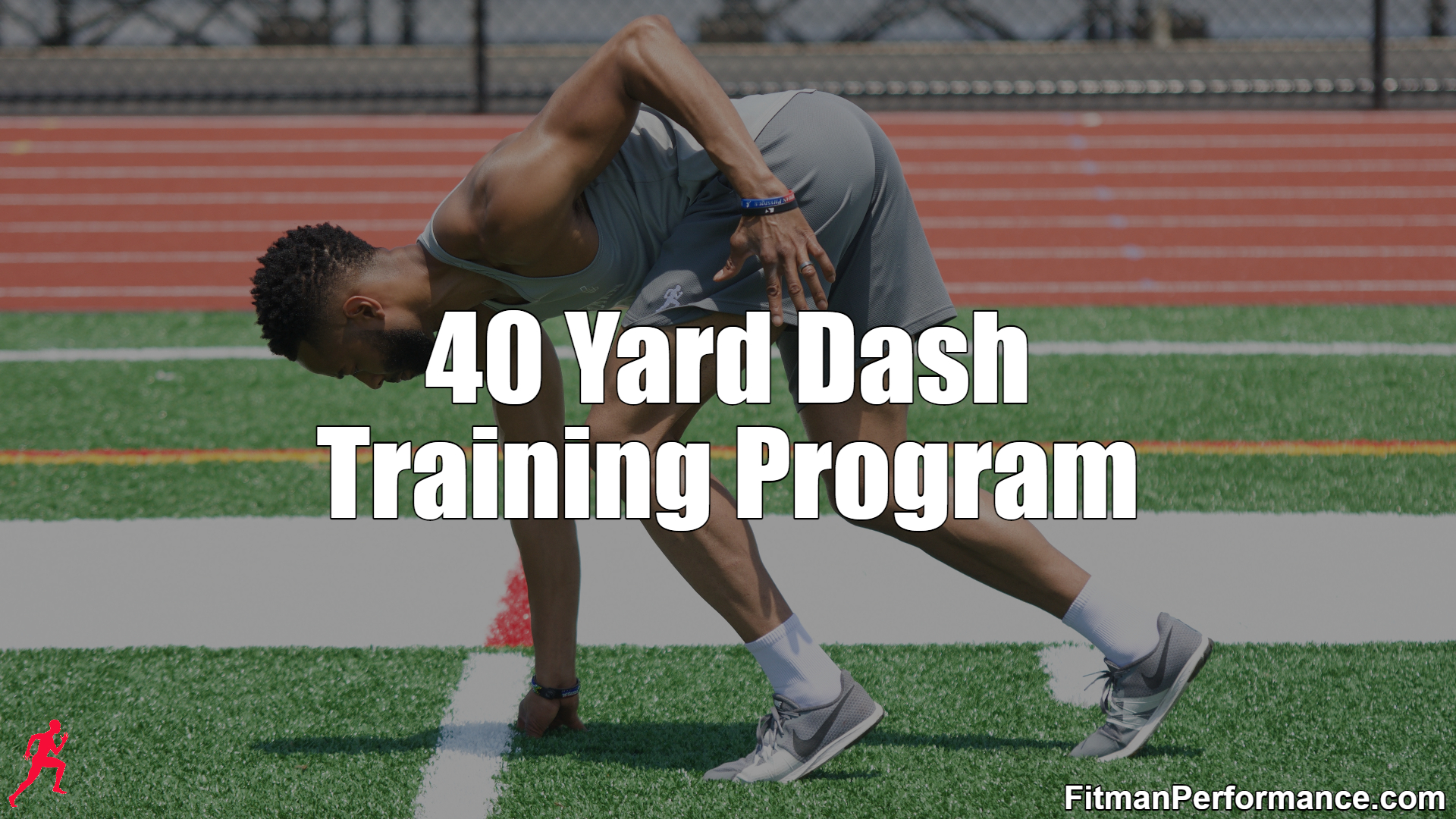The 40-yard dash is a test used at the NFL Combine to measure the straight line acceleration of an athlete.
Of all the tests used to measure a football player at the Combine, the 40-yard dash is the unquestioned star of the show.
Truth Disclaimer
Speed is important in football and especially if you play a skill position like wide receiver or cornerback.
The time that you run in the 40 is also important in terms of where you get drafted.
The difference between a 1st round pick (who gets a big money, guaranteed contract) vs. a 3rd round pick (who has no guarantees) could be .2 seconds (4.41 vs 4.61).
But even with that said, the truth is that the 40-yard dash is not the ultimate, or even a good predictor of what type of football player a guy may be during his career.
The great Jerry Rice ran a 4.71, which is relatively slow for a wide receiver.
But Jerry Rice was a phenomenal route runner, has Spider-Man like hands, was incredibly conditioned, and did not get run down by trailing cornerbacks.
Despite not having elite 40-yard dash speed Rice is the greatest wide receiver of all time, despite what Randy Moss says.
In 2017, John Ross ran an utterly ridiculous 4.22 in the 40 which is the NFL Combine record.
Ross is the fastest receiver of all time but unfortunately, he has struggled big-time with injuries and production on the field.
Just because you are blazing fast does not mean you will be a first class wide receiver.
But if I had two guys, who were essentially the same across the board, I would definitely want the faster guy.
Phases Of The 40-Yard Dash
Before we get into the program, you have to know exactly how to run the 40-yard dash.
There are essentially 3 phases to the 40-yard dash.
I will provide videos of one of my personal favorite sprinters, the great Michael Johnson setting up for and coaching the 40-yard dash for an athlete at his gym.
His video on the 40-yard dash is by far the best one I’ve seen.
For those that do not know, Michael Johnson is a former world record holder in the 200m and 400m dashes. He blazed a 19.32 in the 200m (1996 Olympics) and 43.18 in the 400m (1999 World Championships).
When one of the greatest sprinters of all times starts talking, you better shut your mouth and listen!
1) The Start
Athletes who run the 40-yard dash for football will use a 3 point stance.
A 3 point stance is a starting stance in sprinting where you have 3 points of contact (hand, knee, feet) with the ground. To set up your starting position you will use one of the following two methods.
The Two-Step Method
- Take one step back from the starting line with your power leg (typically the opposite leg of your dominant arm).
- Take another step back with your other leg (quick leg). The steps you take will generally be the length of your foot apart, but you can make slight adjustments if needed.
- Kneel down on the leg that is the farthest back. For the 3-point start place the hand that is closest to your quick leg (the fingers) on that side of the track or grass.
- Place your other arm right next to your body.
- Raise your hips in the air and lean slightly forward. Your hips should be slightly above your shoulders.
The Three Step Method
- Take one step back from the starting line with your quick leg (typically the same leg of your dominant arm).
- Take another step back with your other leg (power leg).
- Take a third step back with your quick leg. The steps you take will generally be the length of your foot apart. (adjust slightly if needed)
- Kneel down on the leg that is the farthest back. For the 3-point start place the hand that is closest to your quick leg (the fingers) on that side of the track or grass.
- For the 3-point start place your other arm right next to your body.
- Raise your hips in the air and lean slightly forward. Your hips should be slightly above your shoulders.
2) Drive Phase
The drive phase is your initial acceleration out of the 3 point stance.

From the start through about the 15 yard mark you will be in the drive phase of the sprint.
This means that you will have a forward body lean while trying to push your feet through the turf behind you.
During the drive phase you are not in a full sprint yet, so you do not want to stand up too early.
Standing upright too early will cause you to hit your maximum velocity (false max) before you are supposed to.
This will ultimately make your time slower if your transition from the drive phase to your maximum velocity is not smooth.
3) Maximum Velocity
The maximum velocity phase of the 40 takes place from about the 20 yard mark through the finish line.
40 yards is a short distance, so you never hit a true maximum velocity during the race. It’s all relative.
When you are transitioning out of the drive phase, you will gradually begin to lift your head and body into an upright position.
During the maximum velocity phase of the 40 you will be driving your arms with a relaxed face as you sprint towards the finish line.
40-Yard Dash Workout
As with most of the workouts I provide at no cost on this website, you can use this specific 40-yard dash workout for 3 weeks before deloading for 1 week.
The protocol for sprinting a faster 40-yard dash is actually pretty simple on paper.
You will sprint 3 days each week with different goals for each day. Because you are sprinting frequently, your overall training day volume will be relatively low.
One day will focus on your start and your acceleration. Acceleration is defined as how long it takes you to reach your top speed.
One day will focus on maximum velocity. Maximum velocity is your absolute top speed.
One day will focus on a mixture of both.
40-Yard Dash Sample Training Split (5 Day Split, 3 Week Program)
Notes:
• Perform my sprinter warm-up before you sprint.
• The worst thing you can do is to skip the warm-up and blow out your hammy. Don’t let your ego ruin your chances to get faster.
• You will maximize your sprinting performance by getting 7-8 hours of quality sleep per night.
• Sprinting is reliant on a fresh nervous system.
• The best way to track your times would be to invest in the Freelap Timing System.
• If you cannot make that investment at this time, you could have a coach time you. Just know that the times will not be as accurate as Freelap, but something is better than nothing!
• When I first started electronically timing my 40-yard dash in early 2017, I was embarrassingly slow. I ran a lousy 5.35 in 2017!
• My best training time came in August 2020 at age 37. I went 4.97 in the 40 which is equivalent to what Jameis Winston ran at his combine in 2015.
• It’s a great improvement for me, but I’m not even close to satisfied. I’m aiming to run 4.8 this summer!
• At age 34, I was decently ranked in the vertical jump (33.5 inch vertical and 36.5 inch max vertical) in terms of the NFL/NBA Combine. I am working to get my 40-yard dash time down to a respectable level as well.
Sunday: OFF
Monday: Starts/Acceleration
3 x 10y
3 x 20y
• Rest at least 2-3 minutes in between reps for your sprints.
• The longer the sprint, the longer the rest. Your speed should be at 95 percent.
Tuesday: Lower Body
Safety Bar Squat SS Glute Ham Raise 2 x 5
RDL SS Barbell Hip Thrust 2 x 8
Seated Calf Raises 3 x 10
• Rest 2 minutes between moves and 3 minutes between sets. Leave 2-3 reps in reserve. Pushing sets to failure has no value for sprinting performance.
Wednesday: OFF
Thursday: Maximum Velocity
3 x 10y fly
3 x 20y fly
• Rest at least 2-4 minutes in between reps for your sprints.
• The longer the sprint, the longer the rest. Your speed should be at 95 percent.
Friday: Upper Body
Dips SS Pull-Ups 3 x 5
Flat Dumbbell Press SS One-Arm Dumbbell Rows 3 x 8
EZ Bar Skullcrushers SS EZ Bar Curls 3 x 10
• Rest 1 minute between moves and 2 minutes between sets.
Saturday: Acceleration/Maximum Velocity
2 x 30y
2 x 30y fly
• Rest at least 3-5 minutes in between reps for your sprints.
• The longer the sprint, the longer the rest. Your speed should be at 95 percent.
Conclusion
The key to running a faster 40-yard dash is not some fake hustle, gimmick “speed” program littered with parachutes, speed ladders, and tools of that ilk.
The key to running a faster 40-yard dash is consistently doing the basics and doing them with the goal of getting better.
Some days will be good and some days will be bad. But true real dealers show up regardless of what type of day it is.
I’ll holla at you next time.
The People’s Trainer
Fitman




[…] the NFL with unbelievable talent and physical attributes. There are some guys running 4.3 in the 40-yard dash and jumping 40 inches in the vertical […]